Lipo Sculpting: Find The Best Method For You!
How to Decide Which Type of Liposuction Is Best for You
Struggling to shed stubborn fat despite diet and exercise? Liposuction might be the solution you're looking for! With various types available, it's essential to understand the differences to make the best choice for your body. Thanks to advancements in technology, there are now more options than ever to achieve your dream body. Ready to take the next step? Explore the types of liposuction and find the one that aligns with your goals. At The Ferguson Clinic, we can perform this procedure for our customer’s convenience. Book an appointment today!
When you are deciding what type of liposuction to get, there are several factors to consider. These include:
The Area(S) Of The Body That You Wish To Have Sculpted
Some of the most common treatment areas for liposuction include the belly, back, buttocks, hips, chin, thighs, upper arms, and chest. During all types of liposuction, surgical tools called cannulas are inserted into the treatment area and fat is removed, but what makes them different is the way fat cells are dislodged and how much fat is removed from the body.
The Amount Of Fat That You Would Like To Have Removed
It Can Be Hard to Predict How Much Fat Will Be Removed.
To ensure that your liposuction is a same-day procedure, the doctor will need to ensure that only five liters of fat or less is removed. This comes out to be about ten pounds of fat.
However, the exact amount of fat your surgeon removes depends on a variety of factors, like how much fat you have in the area, the look you want to achieve, and whether or not the area starts to bleed while the doctor is treating it.
The procedure isn’t as simple as just sticking a vacuum under your skin and sucking out the fat until the machine turns off. It’s a complicated process that your surgeon won’t be able to predict perfectly.
Whether You Want Skin And Tissue Tightening
Even though getting rid of excess fat sounds ideal, there are still some things you should consider when it comes to your post-procedure body. The main thing people don’t expect is the possibility of loose skin.
Over time as we age and as excess fat causes our skin to stretch, our skin loses its elasticity. That means that if you get liposuction in an area with a lot of stretch marks or a place with thin skin, you’ll probably wind up with some sagging skin.
Over time, some of this skin may snap back into place. But the reality is that without a lift, it won’t go entirely back to normal.
Different types of lipo offer some skin tightening but if there is a large amount of excess skin it may need to be surgically removed.
Whether You Can Go Under General Anesthesia
Dr. Ferguson performs all Lipo treatments under general anesthesia to ensure the best experience and results for the patient. Awake lipo is very painful so it is difficult for patients to remain still for the duration of their session, especially if multiple areas are targeted.
Your General Pain Tolerance
Pain varies considerably from person to person. For most, it feels like having a giant bruise in the area that was treated. It shouldn’t be so severe that it keeps you from concentrating on other things (reading, watching TV, walking, etc.). After surgery, you will get the compression garment which can be uncomfortable as it is very tight. You will have to walk around and move frequently to keep your blood flowing.
If you prefer non-invasive lipo, Evolve utilizes a specialized workstation system for radiofrequency body contouring. Both processes steer clear of surgeries and incisions, which makes them minimally invasive.
How Much Time You Can Feasibly Accommodate?
This can take anywhere from 5 to 7 days before you can return to work and 4 to 6 weeks before you can get back to physical activities, such as exercise. A long-term recovery typically lasts 3 months to allow swelling to drain through your lymphatic system. Sessions with a lymphatic drainage massage therapist can assist in speeding up the process to reduce swelling, bruising, and hematomas.
The Fat Won’t Grow Back…
Once your liposuction procedure is over, there won’t be any fat cells in that area anymore. As long as you stay close to the same weight all around, there’s little chance of your weight coming back in that area.
…But Weight Gain Can Happen
However, liposuction doesn’t mean that you won’t ever gain weight again. While you have less fat cells in that area, those cells can still get bigger with weight gain.
What’s worse, because those fat cells won’t ever come back, if you gain a lot of weight after liposuction, other areas of your body will appear to get disproportionately larger.
That shouldn’t deter you from sculpting your body, however. All it takes is a healthy diet and exercise to keep your weight under control.
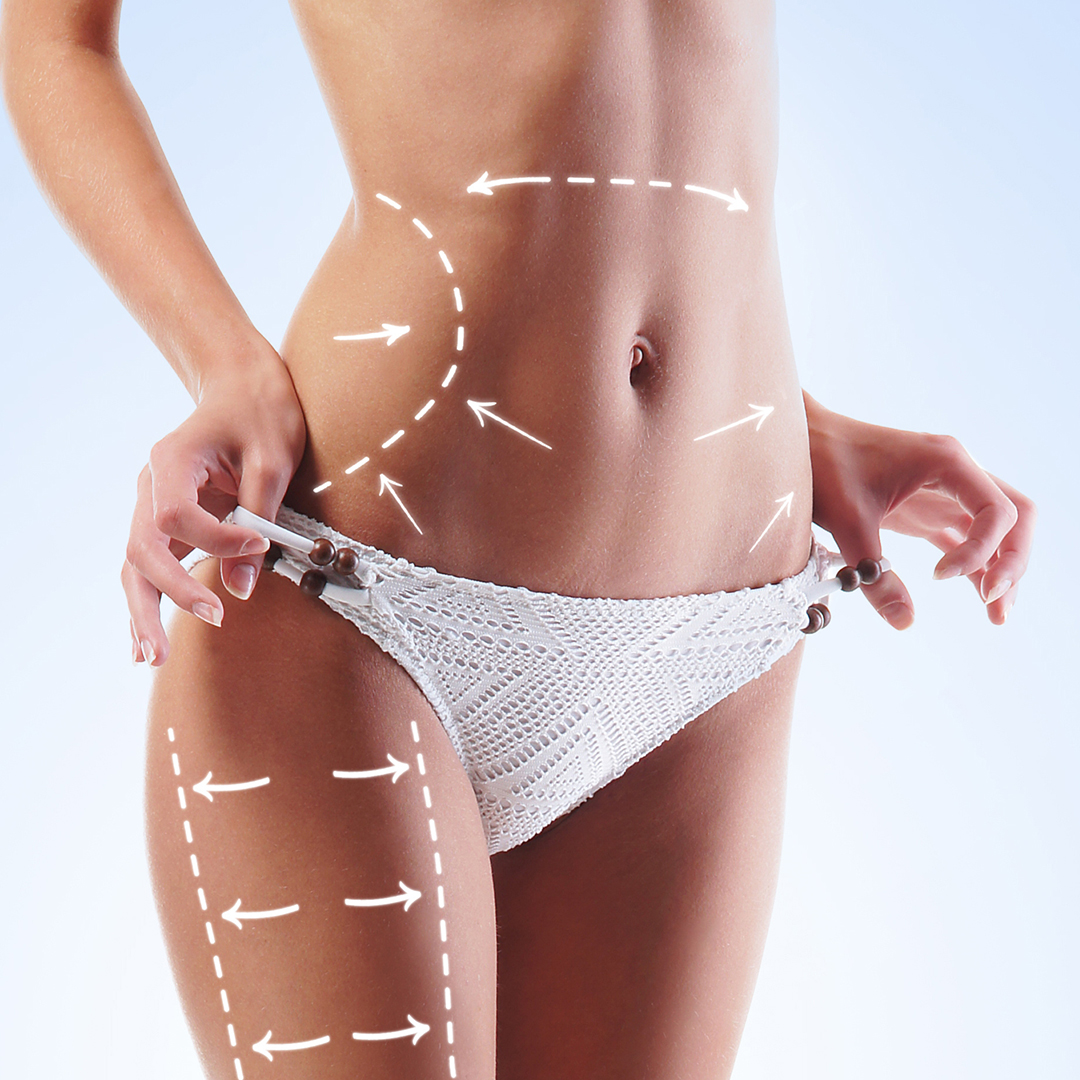
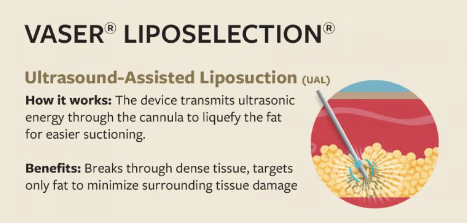
VASER® Liposelection® (Ultrasound)
VASER Liposuction is a form of ultrasound-assisted liposuction (UAL), which breaks up fat tissue using ultrasound energy. VASER stands for “vibration amplification of sound energy at resonance.” Because this energy is targeted only at fat tissue, it causes fewer disturbances to blood vessels and other tissues in the area. Compared to techniques like tumescent liposuction alone, fewer nerves and blood vessels are disturbed during the procedure. As a result, recovery is faster with less bruising and discomfort, along with the smooth body contour.
- Benefits: This approach minimizes damage to surrounding tissue while offering attractive results.
- Best for: VASER works well for breaking up dense fat in both large and small areas.
SmartLipo™ (Laser Lipo)
Also called laser-assisted liposuction (LAL), Smartlipo uses laser energy to disrupt and liquefy fat tissue. The cannula used to suction the fat tissue contains a laser tip that heats and breaks up fat cells while minimizing your risk of bleeding or bruising. The heat generated also stimulates collagen production in your skin, which has a subtle tightening effect.
- Benefits: Smartlipo offers precision, minimized bleeding, and minor skin tightening.
- Best for: This approach works beautifully for detailed muscle etching and contouring small, precise areas.
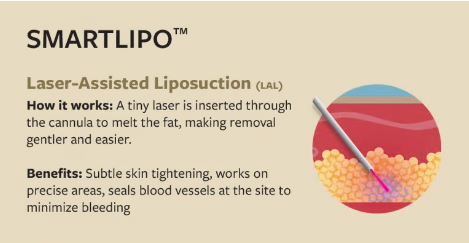
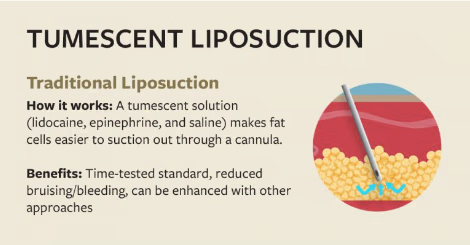
Tumescent Liposuction
Tumescent liposuction, also known as traditional liposuction, involves injecting a solution into fatty areas to make them swell. This solution contains lidocaine to numb the area, epinephrine to reduce bleeding, and saline to saturate the fat. A thin tube called a cannula is then used to break up and suction away the fat cells. This method is effective for various body parts and typically results in less bleeding and bruising compared to other options. While it's considered the standard in liposuction, it may not offer all the advanced features of newer methods. Recovery usually takes about a month, with final results appearing in 3-6 months.
- Benefits: This approach offers reduced bleeding and bruising, and it can be enhanced with other options.
- Best for: Because this is the standard approach, it is effective for most concerns.
Non-Invasive Lipo
For body and limb contouring, Evolve utilizes a specialized workstation system for radiofrequency body contouring.
For facial and submental/jawline tightening and fat removal we reccomend Sofwave, Forma, and EmFace Submentum.
If you want to opt for something more minimally invasive, Morpheus8 microneedling is a great targeted treatment for targeted skin tighening and fat melting.
We do not reccomend of offer CoolSculpting at our clinic as it can result in paradoxical adipose hyperplasia where the fat increases or hardens.
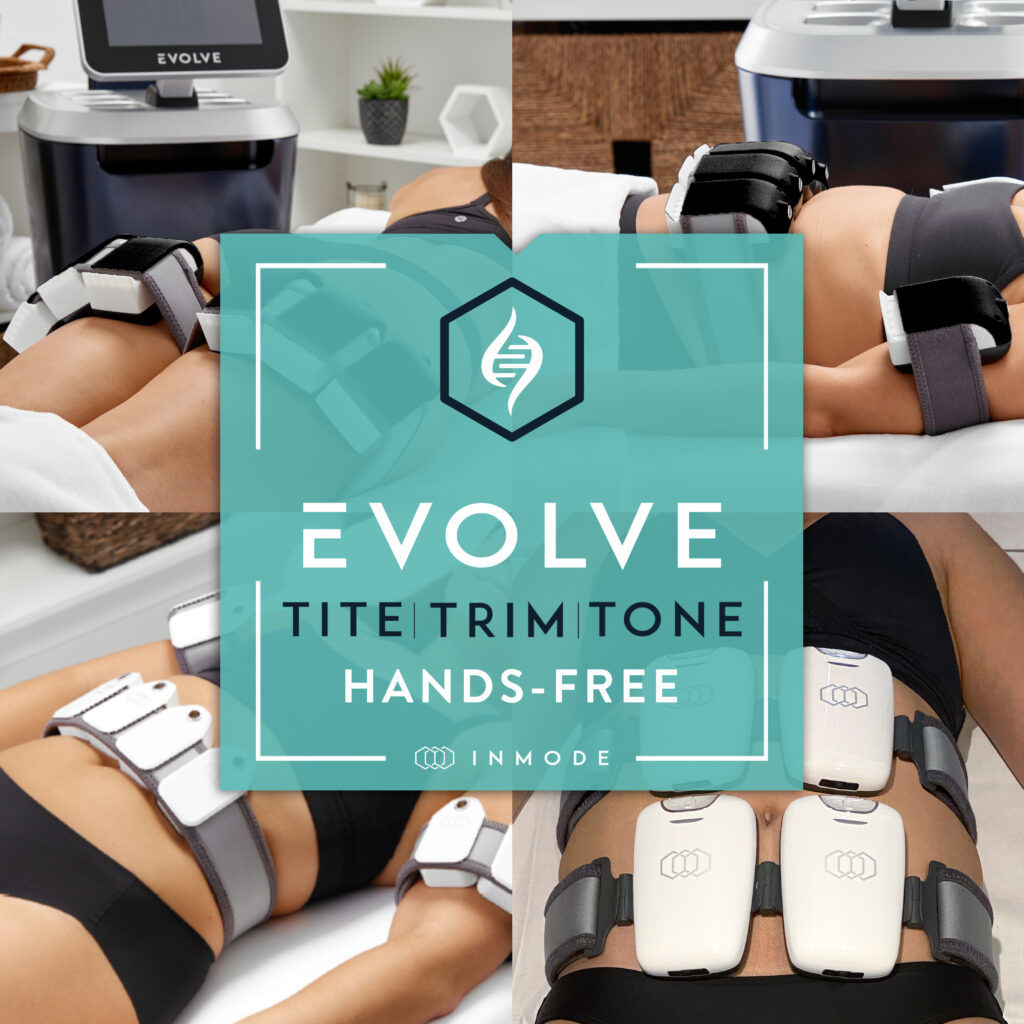
At The Ferguson Clinic, we are the preferred clinic for SmartLipo™, and if you are interested in this procedure, don’t hesitate to reach out to us at your convenience to learn more! Before deciding if SmartLipo™ is right for you, we suggest you consult with our certified team of experts to determine if you are a good candidate for this procedure.
